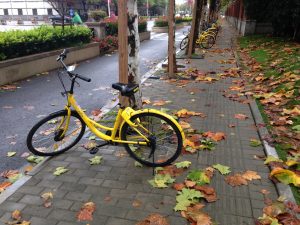The bicycles appear to be coming back to Shanghai. I was their last week for the fifth module of IESE’s Global Executive MBA and was struck by how the bikes have seemed to return to the city after appearing to have lost out to cars and scooters.
I remember when I first went to China about 15 years ago being impressed by the thousands of bikes that clogged the roads. As I go to the city for one reason or another a couple of times per year, I witnessed how motorbikes and cars gradually replaced the bikes until they seemed to be banished from the streets.
 The broad boulevards of the city have very large, dedicated bike lanes running in both directions on either side yet up until a couple of years ago these were mainly filled with scooters. The first change I saw was that the scooters also gradually changed and became increasingly electric.
The broad boulevards of the city have very large, dedicated bike lanes running in both directions on either side yet up until a couple of years ago these were mainly filled with scooters. The first change I saw was that the scooters also gradually changed and became increasingly electric.
Ten years ago these electric scooters came in every imaginable configuration and looked they had been manufactured in people’s garages. Power cords would run between the shops and real estate offices that line the streets and the various types of electric bikes parked outside.
Last week I saw more modern electric scooters and only an occasional power cord. They are actually a bit disconcerting as they run silently down the bike lanes in the dark with their headlights off!
Bikes unchained
Last week the bikes seem to have returned in force driven by technological innovation and a financial business model that is far ahead of similar bike riding schemes like the ones we have in Barcelona and New York City.
The Bicing program in Barcelona, like City Bike in New York, is based on rather heavy bikes that are located at specialized parking locations all over the city. People pay an annual fee to subscribe to the service and then an additional fee fro using the bikes more than 30 minutes at a time. In New York you can also buy a day pass based on the same model. can use the bikes for 30 min. To take out a bike you swipe a special card at the parking station when you pick up a bike and must always put it back at another location. From time to time you see one of the company’s trucks moving bikes from one of the parking stations to another as they fill up in one place or run out in another.

The bikes in Shanghai, on the other hand, do not have any such central locations and can be accessed with a mobile phone. Each bike, and there are competing companies, has a locking mechanism built in to it. To use a bike, you pre-pay a certain amount and then use a telephone app to unlock the bike and go. When you are done you just leave it wherever you want and lock the mechanism.
The locking system is also a GPS hub so that the companies can track their bikes and periodically pick them up for relocation and service.
The cost of the service is 1 rmb per ride which is about $ 0.15. The business model, however, is based on the financial operation of taking in the deposits on the apps. Since you need a minimum amount to open the service, the company is able to finance the acquisition and maintenance of the bikes as well as their operating expenses with the profit they make by having so much positive working capital.
Over the last 18 months ago these different bikes have gotten so popular that the city government has had to paint designated parking areas for them all over the city.
Cars still dominate Shanghai and the city suffers from terrible traffic and air pollution but thanks to innovation, it does seem that bicycles are making a comeback. Ofo and its leading Chinese competitor Mobike are also expanding into the rest of Asia as reported by the Asian Times.


I have seen the “bike graveyards” in China. A sign of the affluence. It is heartening to see that there is an angle that can persuade the Chinese to go back to using bicycles as a means of transportation. Not just for the carbon foot print but also for their health.